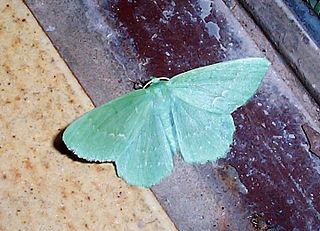
The geometer moths are moths belonging to the family Geometridae of the insect order Lepidoptera, the moths and butterflies. Their scientific name derives from the Ancient Greek geo γεω, and metron μέτρον "measure" in reference to the way their larvae, or inchworms, appear to measure the earth as they move along in a looping fashion. A very large family, it has around 23,000 species of moths described, and over 1400 species from six subfamilies indigenous to North America alone. A well-known member is the peppered moth, Biston betularia, which has been subject of numerous studies in population genetics. Several other geometer moths are notorious pests.

The large emerald is a moth which is the type species for the family Geometridae. It is found throughout the Palearctic region and the Near East in and around deciduous forests, heathlands, marshland and in settlements close to woodland. The species was first described by Carl Linnaeus in his 1758 10th edition of Systema Naturae.

The common emerald is a moth of the family Geometridae. The species is found throughout the Nearctic and Palearctic regions and the Near East. It is mostly commonly found in the southern half of the British Isles. It was accidentally introduced into southern British Columbia in 1973.

The small fan-footed wave is a moth of the family Geometridae. The species was first described by Johann Siegfried Hufnagel in 1767.

The riband wave is a moth of the family Geometridae. The species was first described by Carl Linnaeus in his 1758 10th edition of Systema Naturae.

The spinach is a moth of the family Geometridae. The species was first described by Johan Christian Fabricius in 1787. It is found throughout much of the Palearctic region and the Near East though its distribution is rather local due to its specialized larval food plant. In the British Isles it is fairly common in England and Wales but much rarer in Scotland and Ireland.

The common marbled carpet is a moth of the family Geometridae. It is sometimes placed in the genus Chloroclysta. It is very common throughout the Palearctic region and the Near East. The species was first described by Johann Siegfried Hufnagel in 1767.

The slender pug is a moth of the family Geometridae. It was first described by Jacob Hübner in 1813 and is found throughout Europe and western parts of the Palearctic. The larva feeds on the catkins of willow.

The mottled pug is a moth of the family Geometridae. The species was first described by Jacob Hübner in 1813. It is found across the Palearctic region apart from around the Mediterranean Sea. It is common in the British Isles apart from Scotland where it is rather local.

The currant pug is a moth of the family Geometridae. The species was first described by Henry Doubleday in 1856. It is found across the Nearctic and Palearctic regions .Its occurrence extends eastwards to the Near East, Urals, the Ussuri region and on to the island of Sakhalin. In the Pyrenees and the Alps it rises to altitudes of 1500 and 1800 metres respectively.

The streak is a moth of the family Geometridae. It is found in northern and western Europe and north Africa. It is common in Britain, but local and confined to the north in Ireland. The species was first described by Michael Denis and Ignaz Schiffermüller in 1775.

The latticed heath is a moth of the family Geometridae, belonging to the subfamily Ennominae, placed in the tribe Macariini. The genus was erected by Carl Linnaeus in his 1758 10th edition of Systema Naturae.

The swallow-tailed moth is a moth of the family Geometridae. The species was first described by Carl Linnaeus in his 1758 10th edition of Systema Naturae. It is a common species across Europe and the Near East.

The dotted border is a moth of the family Geometridae. The species was first described by Johan Christian Fabricius in 1776. It is found throughout Europe, except the far north, and the Near East.

The willow beauty is a moth of the family Geometridae. It is a common species of Europe and adjacent regions. While it is found widely throughout Scandinavian countries, which have a maritime climate, it is absent from parts of the former USSR which are at the same latitude but have a more continental climate.

The common wave is a moth of the family Geometridae. The species was first described by Giovanni Antonio Scopoli in his 1763 Entomologia Carniolica. It is found throughout the Palearctic region and the Near East.

Campaea margaritata, commonly known in the UK as the light emerald, is a moth of the family Geometridae. The species was first described by Carl Linnaeus in his 1767 12th edition of Systema Naturae. It is widely distributed throughout Europe, the Near East and North Africa. The habitat is mixed forests including parks and large gardens.

The brimstone moth is a moth of the family Geometridae. The species was first described by Carl Linnaeus in his 1758 10th edition of Systema Naturae. It should not be confused with the brimstone butterfly Gonepteryx rhamni.

Scopula imitaria, the small blood-vein, is a moth of the family Geometridae. It was first described by Jacob Hübner in 1799 and it is found throughout Europe and in North Africa.

Timandra is a genus of moths in the family Geometridae first described by Philogène Auguste Joseph Duponchel in 1829.





















